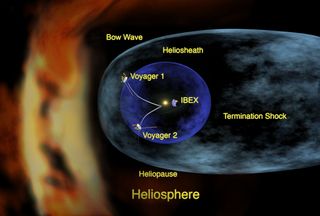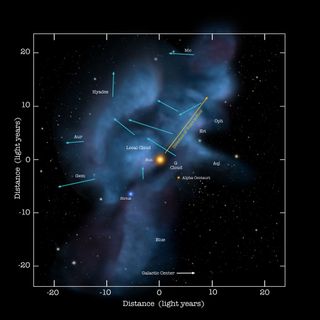For over a decade, NASA's Interstellar Boundary Explorer (IBEX) has been probing the outer edge of the heliosphere, or the "bubble" that surrounds our solar system, to better understand the boundary between the sun's environment and interstellar space. Winds from the sun create the heliosphere, and its boundary serves as a protective shield from some of the harshest radiation generated by other stars.
"IBEX's sole, focused science objective is to discover the global interaction between plasma from the solar wind and the interstellar medium at the boundary region of the solar system," according to the Southwest Research Institute (SwRI) in San Antonio, which leads the mission.
Launched on Oct. 19, 2008, from the Marshall Islands, IBEX rode into space aboard a Pegasus rocket dropped from an L-1011 aircraft. Before IBEX, the Pegasus had carried spacecraft only into low Earth orbit. However, IBEX had an additional solid rocket motor and its own onboard propulsion system to boost itself into orbit above the planet's radiation belts.
A glimpse of the spacecraft
Roughly the size of a bus tire, IBEX carries only two scientific instruments: IBEX-Hi and IBEX-Lo. These doughnut-shaped devices collect energetic atoms that have no charge and record the direction that the particles came from.
Which uncharged particles the IBEX-Hi and -Lo sensors detect depends on each particle's energy level, with high-energy particles visible to IBEX-Hi and lower-energy particles picked up by IBEX-Lo. Known as energetic neutral atoms (ENAs), the particles are produced as charged particles in the solar wind steal electrons from the cool neutral gas ions that are part of the matter and radiation floating around in space, called the interstellar medium.
As the spacecraft orbits Earth, it spins around in place about four times a minute while keeping its solar panels constantly pointed at the sun. IBEX-Hi and IBEX-Lo sit perpendicular to the solar panels and collect neutral atoms all year long. As the satellite spins, each device has the opportunity to gather ENAs from multiple directions. The IBEX research team then creates a map of where every particle came from.
After its launch, the spacecraft followed a series of oval orbits around the Earth, gradually spiraling. However, this put IBEX in the range of the moon's gravity, and the slight tug from the moon shifted the spacecraft's orbit, making the orbit unstable. In 2011, IBEX moved from its spiral path to a new path that keeps the spacecraft out of the gravitational reach of the moon and is therefore more stable. Now, IBEX takes 9.1 days to complete an orbit. Its stable orbit will allow IBEX to continue to collect data far into the future, NASA said.
A bubble in space
As the sun and its planets travel around the galaxy, they aren't moving through empty space. Gas and dust fill the gaps between the stars — a region known as interstellar space. The solar wind carries charged particles from the sun, pushing against this gas and clearing out a bubble-like region around the solar system known as the heliosphere.
Within the heliosphere and around the solar system is the termination shock boundary. This marks the outer limit of the sun's influence, where the solar wind particles begin traveling slower than the speed of sound. The diameter of the termination shock changes based on the activity of the solar wind.
Between the termination shock and the heliopause is the heliosheath, the zone where solar wind particles are compressed and become turbulent as they interact with the interstellar medium that has breached the heliopause. The outermost edge of the heliosphere is the heliopause, the final divide between the interstellar medium and the region of the sun's influence.
So far, only two spacecraft have traversed the termination shock. The Voyager 1 spacecraft crossed the border in 2004, and Voyager 2 crossed it in 2007. Pioneer 10 and 11 will be the next spacecraft to cross over the border, followed by New Horizons. Exactly when those craft will pass the boundary is uncertain, because the distance to the termination shock is ever-changing.
The heliosphere isn't a perfect circle around our solar system; instead it's shaped more like a teardrop, with a comet-like tail that drags behind the sphere as the sun moves through the Milky Way. The tail extends out from our solar system farther than the other side, which is pushing forward through space in the direction of the sun's travel. However, IBEX revealed that the tail region of the heliosphere doesn't extend as far as astronomers had thought.

An artist's concept of our heliosphere, which is a bubble in space created by the solar wind and solar magnetic field.
Probing the shield
IBEX created its first map of the heliosphere over the summer of 2009. With every spin of the spacecraft, IBEX maps a single strip of the sky, with the entire sky mapped every six months.
"For the first time, we're sticking our heads out of the sun's atmosphere and beginning to really understand our place in the galaxy," David J. McComas, IBEX principal investigator and assistant vice president of the Space Science and Engineering division at Southwest Research Institute, said in a statement. "The IBEX results are truly remarkable, with a narrow ribbon of bright details."
From the start, IBEX revealed a puzzle: a strange, dense region of particles thereafter known as the IBEX ribbon. This ribbon arises because of the interaction of the solar wind with other cosmic phenomena. As the neutral hydrogen atoms carried by the solar wind cross the galactic magnetic field, it strips away the hydrogen's electrons, turning the atoms into charged particles known as ions. The ions then interact with the magnetic field, spiraling around the field lines. According to a 2013 paper published in The Astrophysical Journal, the rapid rotation creates waves or vibrations in the magnetic field, trapping the ions in ribbon-like regions. Some of these ions are fired back toward the sun, and toward IBEX.
"Think of the ribbon as a harbor and the solar wind particles it contains as boats," Nathan Schwadron, a scientist at the University of New Hampshire, Durham, said in a statement. "The boats can be trapped in the harbor if the ocean waves outside it are powerful enough. This is the nature of the new ribbon model. The ribbon is a region where particles originally from the solar wind become trapped or retained due to intense waves and vibrations in the magnetic field."
In addition, IBEX's sensors captured interstellar particles of hydrogen, helium, oxygen and neon, then calculated that the particles enter the heliosphere at 52,000 mph (83,685 km/h) rather than the 59,000 mph (95,000 km/h) suggested by earlier observations. The particles also enter the solar system from a different direction than previously thought, likely due to magnetic forces at the heliosphere's boundary.
The slower speed means that the heliosphere lacks the bow shock that would otherwise be expected to form as the region plows through space, pushing interstellar material out of the way like a boat moving through water.
"With this lower speed, the external magnetic forces cause the heliosphere to become more squished and misshapen," McComas said. "Rather than being shaped like a bullet moving through the air, the heliosphere becomes flattened, more like a beach ball being squeezed when someone sits on it."

The solar journey through space is carrying us through a cluster of very low density interstellar clouds. Right now the Sun is inside of a cloud that is so tenuous that the interstellar gas detected by IBEX is as sparse as a handful of air stretched over a column that is hundreds of light years long. These clouds are identified by their motions.
Teamwork in space
IBEX isn't working alone. The lack of bow shock was discovered by combining the spacecraft's data with information from the Voyager spacecraft. While IBEX provided a look at the entire region from a distance, Voyager 1 and 2 were able to take measurements from inside the boundary at two different regions.
"The combination of IBEX and Voyager gives you great science," IBEX mission scientist Eric Christian, who was formerly the program scientist for Voyager, said in a statement.
NASA's Cassini spacecraft, which orbited Saturn for over a decade, also helped to measure the heliosphere, collecting particles at higher energies than what IBEX could detect. IBEX also worked with NASA's Two Wide-Angle Imaging Neutral-Atom Spectrometers (TWINS), which observed the impact of a solar storm from inside the Earth's magnetic field, while IBEX measured it from the exterior.
"This imaging gives us a better global picture of the evolution of the [Earth's] magnetosphere — especially of the processes by which the sun injects energy into the magnetosphere — than has ever been available before," McComas said in a statement. "It's a cool combination of two data sets that opens the door to much more sophisticated global studies."
Further resources:
Bagikan Berita Ini















0 Response to "NASA's IBEX Mission: Exploring the Edge of the Solar System - Space.com"
Post a Comment